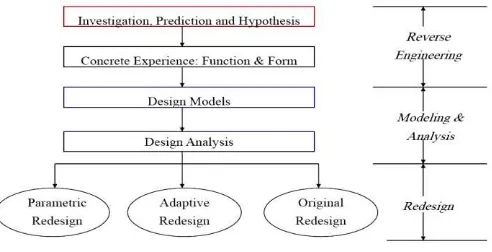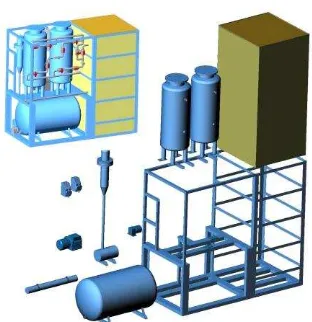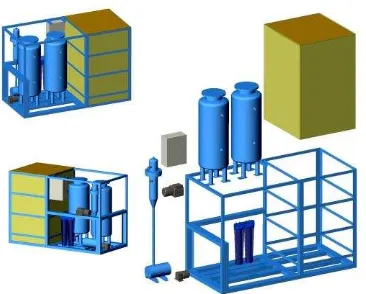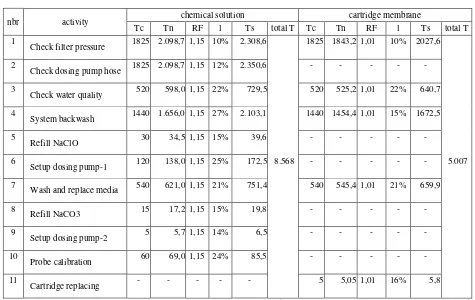a Case of Substituting Chemical Solution with
Cartridge Filtration for Small Water Treatment
Unit
Gamawan Ananto
#, Retno Hadi
#, Indra Priasmara
# #Manufacture Engineering Department, Bandung State Polytechnic For Manufacturing (POLMAN) Jl.Kanayakan 23, Bandung 40135, Indonesia
1
waloeyo_gamawan@yahoo.co.uk
Abstract— A small Water Treatment unit in an educational institution has been in operation for about six years, provided clean and drinking water for the inhabitants of such organization. The chemical solution process that combined with media filtration is applied for such machine. Although there was no complaint from inhabitants as the customer, the manager in charge who responsible in operation noticed that sometimes is not easy to control the technicians in carrying out its routine and periodic detail technical procedure consistently, that might influence the output quality. To make the operation easier, a few lab scale experiments are initiated due to find out whether using cartridge filtration that is still combined with media filtration could reduce their efforts. The experiments skipped chemical features and added Micro Filtration (MF) cartridge to get the lab result of output water. Reverse Engineering and Redesign is used for analyze its design aspect whereas Westinghouse approach measured its efforts in handling. The result shows that using cartridge gave a moderate quality in water composition of element content that is still in standard range of health provision; but it needed lower effort and had better aspect of design.
Keywords
—
water treatment, chemical solution, sand filtration, micro filtration, design modificationI. INTRODUCTION
As known, water is a vital issue for human being. Since nowadays there are a lot of factors that influenced natural water sources quality by contamination or pollution, people are pushed to manage and develop various technologies in water processing, in order to get their purposes for clean and drinking water with appropriate health quality standard. Referred to capacity needed, various water treatment system are built for towns, districts, small community and even family house; either by Government, corporate or private.
As a case, small Water Treatment unit with 1m3 per hour capacity in an educational institution has been in operation for about six years, provided clean and drinking water for the inhabitants of such organization. The chosen system for such unit is chemical solution for oxidation and disinfection process that combined with media filtration. This system
worked well from quality output point of view, as far as its operation procedure carried and managed tidily.
Although there was no complaint from inhabitants as the customer, the manager in charge who responsible in operation noticed that sometimes is not easy to control his technicians in carrying out its routine and periodic detail technical procedure consistently. As soon as a certain action is not done, it might influence the output water quality worse. Therefore a modification is considered to be initiated in order to make the system safer and its operation procedure easier.
II. LITERATURE REVIEW
A. Water Treatment technology
In physical filtration process there is rapid sand filter or rapid gravity filter, a type of filter used in water purification and is commonly used in municipal drinking water facilities as part of a multiple-stage treatment system. Rapid sand filters use sand and other granular media to remove particles and impurities that -in some cases- have been trapped in a flock through the use of flocculation chemicals.Water and flock flows through the filter medium and the flocculated material is trapped in the sand matrix. Thus, chemical additivesare often used in conjunction with the filtration system [3]. Meanwhile, a few grades of physical filtration in Fig. 1 [4] shows that conventional filtration process may overcome undissolved compound content up to around 1µm dimension, whereas themost extreme condition such as seawater or brackish with salts content has to use RO (reverse osmosis) membrane.
Fig.. 1 Water Treatment physycal filtrationgrade [4] (Heijman S.G.J, CT4471, Nanofiltration and Reverse Osmosis, 2007)
Generally, membranes technology could be used for non terrible condition since a low fouling potential could be obtained by membranes whereas sand filter is better at removing manganese and dissolved organic matter. It is experimented that combining aeration, sand filtration and membrane techniques might be a good option for pesticide removal without any addition of chemical and also minimized membrane maintenance [5]. For certain cases; combining chemical addition and physical filtration is a good solution for certain input and output water quality level, where its design has to be defined conditionally.
B. Reverse Engineering
Veryfew methodologies exist that focus on the class ofproblems known as redesign (adaptive, variant, etc.). As with original design, redesignproblems include the many of process steps referred as‘reverse engineering’. Reverse engineeringinitiates the redesign process, wherein a product ispredicted, observed, disassembled, analyzed, tested,‘experienced’, and documented in terms of itsfunctionality, form, physical principles, manufacturabilityand assemb-lability. The intent of this
processstep is to fully understand and represent the currentinstantaneous of a product. Based on the resultingrepresentation and understanding, a product may beevolved, either at the subsystem, configuration,component or parametric level[6].
Fig. 2 shows the simplified steps in reverse engineering methodology [7] that adopted from Otto and Wood’s ‘Reverse Engineering and Redesign methodology’ UT Austin [6].
Fig. 2 Reverse Engineering steps
It consists of three distinct phases; reverse engineering, modeling and analysis, andredesignthat are covering its each sub phases. On the final stage that initiatedthe product redesign based on theresults of the reverse engineering and modelingphases; there are parametric redesign, adaptive redesign and original redesign as the alternatives. Regarding original redesign there might be effort needed to satisfy thecustomer needs since it implies that a major conflict exists between thecustomer or user needs and the current product in the fact [6].
C. Westinghouse
III.METHODOLOGY
Referred to the way of thinking of such Otto and Wood’s Reverse Engineering and Redesign methodology, the stages to find appropriate things for the case as shown on Fig. 3.
Fig. 3The stages in improving small Water Treatment case
On investigation, the original or existing design is treated through ‘black box’ model that is reviewing its input and output only; and exploring the working principles, block diagram, product assembly drawing with exploded view, and other necessary technical specification. Developing idea stage includes lab scale trials with new or addition sub system, and this will be a basic to follow up the redesign concept. The theoretical evaluation then could be calculated to compare existing and new design.
IV.RESULT AND DISCUSSION
A. Existing design investigation
Since the discussed case is using raw water from the ground or well, the treatment do not need any process that usually applied for surface water source such as coagulation and flocculation. According to the raw water contents, the machine is designed originally with chemical oxidation and disinfection process only, where these processes are controlled by each dosing pump in order to make its chemical solution doses keep consistent as required, as shown in the block diagram on Fig. 4.
Fig. 4Water Treatment with chemical solution block diagram
Raw water input that is taken by feeding pump flows through hydro cyclone as first rough process in separating and removing the most solid suspended substances with parts size larger than 0.2 mm. The chemical solution for pH controller, oxidation and pre-disinfection then are added into the flow by dosing pumps in the control panel box and it is following with mixing up by static mixer, it then goes into retention tank to optimize the mixing process. These chemical processes then followed with physical filtration by granular media that put in two media tanks. On final stage, the disinfection process is added before the output water is collected into the accumulation tank. All mentioned components are illustrated by Fig. 5 except dosing pumps that mounted in the control panel box.
Fig. 5 Original product assembly (left) and exploded view (right)
Regarding black box model point of view in investigating, the samples from raw water that stated as input and produced result water as output of such original design are tested and checked by authorized water lab.
B. Develop idea
and mature product, such experiments did not make any test for this kind of disinfection that supposed will substitute chemical disinfection.
Fig. 6Water Treatment with cartridge and UV block diagram
Below mentioned Fig. 7 is the modified product assembly illustration with its exploded view, referred to Fig. 6 block diagram. It is clearly shown that previous static mixer and retention tank are not used any longer since they are needed for chemical process only. Due to retention tank dimension that relatively big, the total height of new design seemed could be reduced, with a minor consequence that accumulation tank capacity will be a bit lower, too.The same as original design investigating, the samples of produced result water as output of this modified design are tested and checked by water lab.
Fig. 7Modified product assembly (left side, above and below) and exploded view (right side)
C. Evaluate, comparing existing and new design
The result shows that using cartridge, instead of chemical ingredient, gave a moderate quality in water composition of element content that is still in standard range of health provision; in this case, referred to Indonesian Government rule for drinking water ‘Permenkes 492/2010’, as shown in Table 1. The explained values are actually the most important
parameters only, as stated. It is fortunately right that all parameters of raw water input are already in acceptable range of value, but operate the system without using any chemical ingredients mainly due to smaller space required and less sensitivity to input water quality variations [9] that could be influenced by weather changes.
TABLE 1
WATER LABORATORIUM CHECK RESULTS
parameter unit max. standard
result
raw chem cartdg
turbidity NTU 5 0,38 0,40 0,82
TDS mg/l 500 120 205 190
colour PtCo )* 15 5 5 5
Fe mg/l 0,3 < 0,04 < 0,04 < 0,04
pH mg/l 6.5-9.0 7,27 7,58 7,31
Mn mg/l 0,4 0,26 0,14 0,03
KMnO4 mg/l 10 < 0,10 < 0,10 2,08
)* TCU scale
From design aspects that reviewed through Reverse Engineering and Redesign tools it is found that by using modified design with Micro Filtration cartridge, a few advantages are occurred compared with chemical solution design; these are 1)smaller space required, 2)total weight of machine is reduced, and 3)less cost investment is needed. These parameters are analyzed from number of more detail calculation. Retention tank deletion for instance, with approximately 600 diameter times 1000 length (in mm) dimension could decrease space and weight significantly. Nullification of dosing pump that relatively expensive, might contribute cost down as well.
Resulted by Westinghouse method; Table 2 of small water treatment unit case shows that compared with chemical solution, using micro filtration cartridge had a smaller effort from the assigned technicians side. The detail calculation is not mentioned due to limitation space of paper work.
V. CONCLUSION
technicians effort in operation and a few lab scale experiments with micro filtration cartridge. The result shows that using cartridge, instead of chemical ingredient, gave a moderate quality in water composition of element content that is still in standard range of health provision; needed lower effort and had better aspect of design. However, more experiments and detail measures is recommended to be explored and developed.
REFERENCES
[1] Badan Standardisasi Nasional,Air Minum Dalam Kemasan, (SNI 01-3553-2006), 2006.
[2] Howe Kerry J, Hand Davis W, Crittenden John C, Trussell P Rhodhes, Tchobanoglous George, Principles of Water Treatment, John Wiley & Sons, Inc, New Jersey, 2012.
[3] Rafi Mahammad, Rachamar T, Umamahesh M, Babu B Arun, Fabrica-tion & Testing of Rapid Sand Filter Equipment, Global Journal of Researches In Engineering, Chemical Engineering, vol 12 issue 2 ver 1.0, ISSN 2249-4596), 2012.
[4] Heijman S G J, CT4471, Nanofiltration and Reverse Osmosis, TU Delft, p2, 2007.
[5] Kowalski Krzysztof P, Madsen Henrik T, Sogaard Erik G, Comparison of sand and membrane filtration as non-chemical pre-treatment strategies for pesticide removal with nanofiltration/ low pressure reverse osmosis membranes, Water Sciennce & Technology: Water Sully vol 14 no 4 pp 532-539, IWA Publishing 2014 doi 10.2166/ws.2014.004), 2014.
[6] Otto Kevin N, Wood Kristin L, Product Evolution: A Reverse Enginee-ring and Redesign Methodology, Research in Engineering Design (1998)10:226-243, Springer-Verlag London Limited, 1998.
[7] Bani Younis Mohammed, Reverse Engineering, Technische Universi-taet Kaiserlautern.
[8] Cevikcan Emre, Selcuk Kilic Huseyin and Zaim Selim, Westinghouse Method Oriented Fuzzy Rule Based Tempo Rating Approach, Proceedings of the 2012 International Conference on Industrial Engineering and Operations management Istanbul, turkey, p1670-1677, 2012.
[9] SJ Haig, G Collins, RL Davies, CC Dorea and C Quince, Biological Aspects of Slow Sand Filtration: Past, Present and Future, from http://userweb.eng.gla.ac.uk/christopher.quince/sarah.haig/sarahhaigY WPfinished.pdf
TABLE 2
STANDARD TIME COMPARISON
nbr activity chemical solution cartridge membrane
Tc Tn RF l Ts total T Tc Tn RF l Ts total T
1
Check filter pressure 1825 2.098,7 1,15 10% 2.308,6
8.568
1825 1843,2 1,01 10% 2027,6
5.007 2
Check dosing pump hose 1825 2.098,7 1,15 12% 2.350,6 - - - - -
3
Check water quality 520 598,0 1,15 22% 729,5 520 525,2 1,01 22% 640,7
4
System backwash 1440 1.656,0 1,15 27% 2.103,1 1440 1454,4 1,01 15% 1672,5
5
Refill NaClO 30 34,5 1,15 15% 39,6 - - - - -
6
Setup dosing pump-1 120 138,0 1,15 25% 172,5 - - - - -
7
Wash and replace media 540 621,0 1,15 21% 751,4 540 545,4 1,01 21% 659,9
8
Refill NaCO3 15 17,2 1,15 15% 19,8 - - - - -
9
Setup dosing pump-2 5 5,7 1,15 14% 6,5 - - - - -
10
Probe calibration 60 69,0 1,15 24% 85,5 - - - - -
11
Cartridge replacing - - - 5 5,05 1,01 16% 5,8



